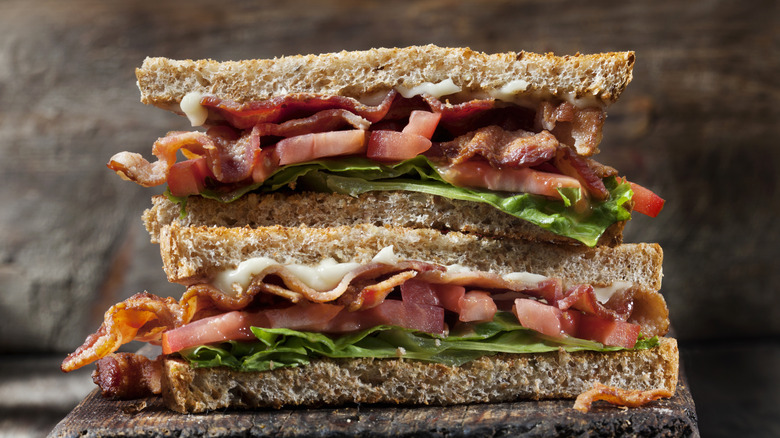Mayo Does Way More For Sandwiches Than Just Add Flavor
So many beloved sandwiches rely on mayonnaise. Clubs, ham and cheese, tomato sandwiches, and countless others see the benefits of the classic spread. Some people slather their sandwiches in mayonnaise for its tangy flavor, while others dollop it on as a creamy addition to an otherwise dry assembly of ingredients. And unless your sandwich construction method diverts from standard practice, you probably spread mayo directly on the bread — but if you don't, now is the time to start. Because that thin layer of mayonnaise is doing more for your sandwich than you might think.
Sure, flavor and texture are big selling points of the condiment, but mayo has structural qualities that spreads like mustard, ketchup, or pesto lack. And these qualities can help save you from one of the most common sandwich grievances: Sogginess. For many, there's nothing worse than biting into damp, gummy bread — but mayo can come to the rescue. The mayo layer actually becomes a barrier that keeps your sandwich from becoming soggy.
Oil helps stop the sandwich sogginess
Mayonnaise is an emulsification of oil, egg, and an acid like lemon juice or vinegar. Oil is hydrophobic, meaning that the molecules are repelled by water — if you pour any kind of oil into a pot of water, the two will stay separated instead of mixing. Even though the eggs in mayo contain water, which shouldn't be able to mix cleanly with oil, mayo is bound by a fat in egg yolks called lecithin. Lecithin is simultaneously hydrophobic and hydrophilic (attracted to water molecules), otherwise known as amphiphilic, and allows all of the mayo ingredients to emulsify. Nevertheless, mayo retains many of its hydrophobic oil qualities in the final product.
It's this hydrophobic attribute that makes mayo such a useful condiment for sandwiches. Whereas non-oil-based condiments or spreads begin to permeate the bread as they sit, causing that dreaded soggy texture, the oil-based mayo becomes a partition between the bread and more moisture-heavy ingredients like tomatoes. This clever condiment trick will prevent a soggy sandwich — just a thin layer of the fat will build a barrier and keep your sandwich tasting and feeling fresh.
Keep your sandwiches fresh for longer
Although many chefs abide by it, the mayo method does have its detractors — those who say that the condiment still contributes to a sandwich's moisture and alters the texture. So if you adhere to that worldview or you're just in search of other techniques for ensuring that your sandwich stays fresh, there are a few other ways to give the mayo a little anti-sogginess assistance.
Bread is a sandwich's foundation (and the primary victim if there's too much moisture), so it's easy to begin with your loaf. John Politte, the chef behind the YouTube channel It's Only Food, told Today Meal that the best way to prevent soggy sandwiches is to toast the bread. The toasted crispiness stops some of that moisture from seeping in, and you get the added benefit of flavor and crunch.
It also helps to get rid of some of the ingredients' excess moisture before you start assembling. Just take a paper towel to damp veggies like tomatoes, cucumbers, pickles, or washed lettuce. Then when you start stacking, place these types of ingredients toward the center of the sandwich instead of directly on the bread. A simple layer of mayo will contribute its oil-fat barrier to the bread and its sandwich structure potential is just one of those uses for mayonnaise that you need to know, but you can give it easy assembly assists like these to make sure you're enjoying the freshest possible sandwich.


